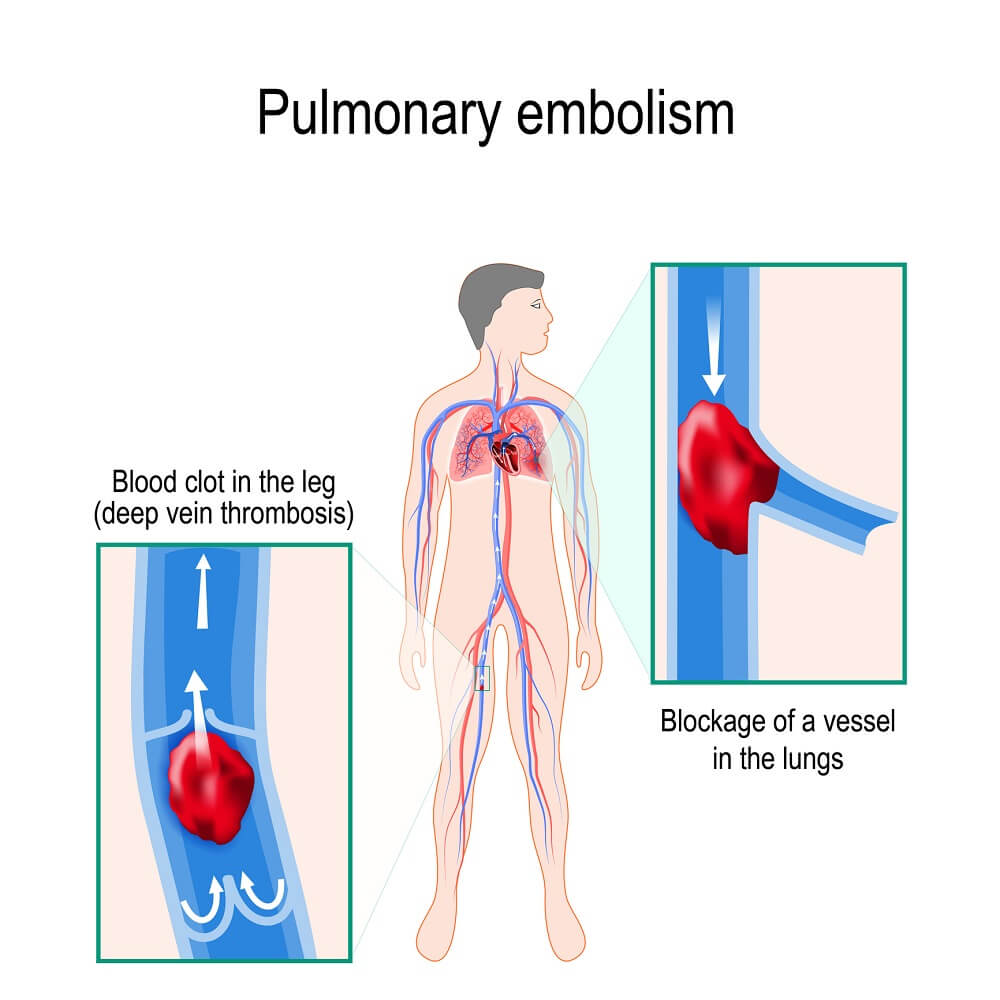Embolism: Definition, Types, Causes, Treatment and MCQs for NEET, GPAT, CSIR NET JRF
INTRODUCTION :-
“Embolism is the process of partial or complete obstruction of some part of the cardiovascular system by any mass carried in the circulation; the transported intravascular mass detached from opits site of origin is called embolus.”
1.] Most usual forms of emboli i.e. 90% are thromboemboli i.e. originating from thrombi or their parts detached from the vessel wall.
TYPES OF EMBOLISM :-
A.] Depending upon the matter in the embolism :
- Solid
- Liquid
- Gaseous
B.] Depending upon whether infected or not :
- Bland, when sterile
- Septic, when infected
C.] Depending upon the source of embolism :
- Cardiac emboli
- Arterial emboli
- Venous emboli
- Lymphatic emboli
D.] Depending upon the flow of the blood :
- Paradoxical embolus
- Retrograde embolus
PULMONARY EMBOLI :-
- Most if the pulmonary emboli arise in the deep leg vein above the level of knee.
- Paradoxical embolus is a rare embolus that can pass through an inter – arterial or inter – ventricular defect, thereby entering systemic circulation.
- Most of the pulmonary emboli (60% – 80%) are clinically silent because they are small.
- They rarely may cause pulmonary infarction.
- Sudden death may also occur in >60% of pulmonary circulation if obstructed.

Above figure is taken for educational purpose only (Credit from-Flushing Hospital)
FAT EMBOLISM :-
- Fat embolism syndrome is characterized by pulmonary insufficiency, neurologic symptoms, anemia and thrombocytopenia.
- It is seen after the fractures of long bones or after soft tissue trauma.
- It is fatal in 10% of cases.
- The pathogenesis involves both mechanical obstructions and free fatty acid causing local toxic injury to endothelial.
CAUSES OF EMBOLISM :-
Most embolisms happen to people who have risk factors for blood clot formation, such as smoking and heart disease. Other risk factors for other types of emboli include high blood pressure, atherosclerosis (buildup of fatty plaque in the blood vessels), high cholesterol, and obesity.
The primary cause of most pulmonary embolisms is deep vein thrombosis (DVT). This is a condition in which the veins of the legs develop clots. Natural agents in the blood often dissolve small clots without causing any effects of blockage. Some clots are too big to dissolve and are big enough to block major blood vessels in the lungs or in the brain.
Factors that slow blood flow in the legs may promote clotting. People can develop a DVT or pulmonary emboli after sitting still on long flights or after immobilization of the leg in a cast, or after prolonged bed rest without moving the legs. Other factors associated with DVT or pulmonary embolism include cancer, previous surgery, a broken leg or hip, and genetic conditions affecting the blood cells that increase the chance of blood clot formation.
TREATMENT AND PREVENTION :-
The treatment for thromboembolism (blood clot embolism) involves anticoagulant or thrombolytic medications.
Anticoagulants, such as heparin, low molecular weight heparin, warfarin, or factor Xa inhibitors, are the main medications given for pulmonary embolism.
Anticoagulants prevent further clotting of the blood.
Thrombolytics such as alteplase and streptokinase help the body to dissolve the original clot. The most effective way to prevent pulmonary embolism is to prevent DVTs from forming or starting to move in the blood vessels. If you have DVT, you may be prescribed an anticoagulant. Anticoagulants can also be given to people with DVT to prevent the condition. They can also protect against stroke.
Non-medication methods to help prevent DVT include using compression devices and compression stockings (to ensure blood doesn’t pool in the legs), and frequently stretching, massaging, and moving your lower leg muscles if you are inactive for a long time.
You can also reduce your risk factors for getting blood clots, for instance by quitting smoking and controlling your blood pressure.
MULTIPLE CHOICE QUESTIONS [MCQs] :-
1.] Fat embolism is commonly seen in ?
a. Head injuries
b. Long bone fractures
c. Drowning
d. Hanging
2.] Having a pulmonary embolism include risk of possible ?
a. Sudden death
b. Diabetes
c. High blood pressure
d. Amputation of limbs
3.] Who is at greater risk for pulmonary embolism ?
a. Men
b. Women
c. Young women
d. The risk is same for both Men and Women
4.] A pulmonary embolism is a blood clot that becomes lodged in the lungs ?
a. True
b. False
5.] If a clot “embolise” this means it has ?
a. Attached itself to another clot
b. Decreased in size
c. Broken loose
d. Hardened
6.] What is most frequent cause of pulmonary embolism ?
a. Congestive heart failure
b. Hemorrhagic fever
c. Deep vein thrombosis
d. Pneumonia
7.] What is pulmonary embolism ?
a. A pulmonary clot obstructing a pulmonary artery
b. Right sided heart failure
c. A blood clot obstructing the aorta
d. None of the above
8.] Which of the following symptoms are not characteristic for pulmonary embolism ?
a. Hemoptysis
b. Cyanosis
c. Painful respiration
d. Hemorrhagic diathesis
9.] What are the symptoms of DVT ?
a. Swelling of the affected leg
b. Cyanosis or redness of the skin above the DVT
c. Warmness of the skin above the DVT
d. Pain in the affected leg
e. All of the above
10.] Medication for DVT and PE are called anticoagulates ?
a. True
b. False
SOLUTIONS :-
1.] (b) Long bone fractures
2.] (a) Sudden death
3.] (d) The risk is same for both Men and Women
4.] (a)
5.] (c) Broken loose
6.] (c) Deep vein thrombosis
7.] (a) A pulmonary clot obstructing a pulmonary artery
8.] (d) Hemorrhagic diathesis
9.] (e)
10.] (a)
REFERENCES :-
1.] Textbook Of Pathology By Harsh Mohan; 7th edition; Page no. 105 – 109.
2.] Robbin’s Basic Pathology; 5th edition; Page no. 111 – 114.